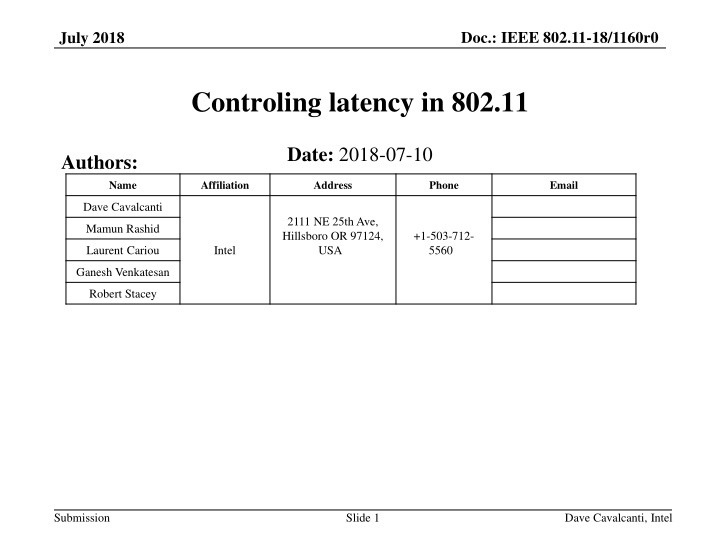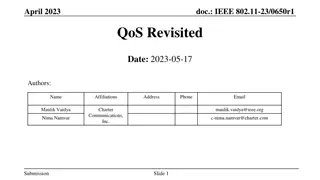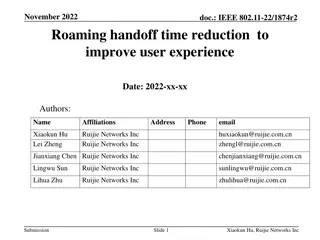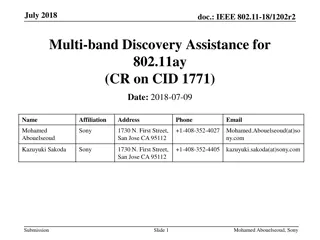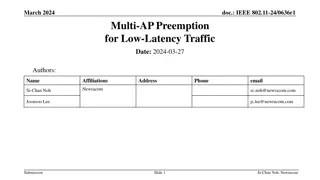Analyzing and Improving Latency in IEEE 802.11 Networks
The document discusses controlling latency in IEEE 802.11 networks to meet the demands of emerging applications that require not only high throughput but also low latency. It covers aspects such as latency analysis, potential improvements, latency vs. reliability trade-offs, and latency improvement with 802.11ax trigger-based access. The focus is on achieving lower latency with higher predictability and reliability in different scenarios by addressing congestion control, overhead challenges, and admission control.
Download Presentation

Please find below an Image/Link to download the presentation.
The content on the website is provided AS IS for your information and personal use only. It may not be sold, licensed, or shared on other websites without obtaining consent from the author.If you encounter any issues during the download, it is possible that the publisher has removed the file from their server.
You are allowed to download the files provided on this website for personal or commercial use, subject to the condition that they are used lawfully. All files are the property of their respective owners.
The content on the website is provided AS IS for your information and personal use only. It may not be sold, licensed, or shared on other websites without obtaining consent from the author.
E N D
Presentation Transcript
Doc.: IEEE 802.11-18/1160r0 July 2018 Controling latency in 802.11 Date: 2018-07-10 Authors: Name Affiliation Address Phone Email Dave Cavalcanti 2111 NE 25th Ave, Hillsboro OR 97124, USA Mamun Rashid +1-503-712- 5560 Laurent Cariou Intel Ganesh Venkatesan Robert Stacey Submission Slide 1 Dave Cavalcanti, Intel
Doc.: IEEE 802.11-18/1160r0 July 2018 Key messages Traditionally, 802.11 has focused on improving peak throughput, capacity, and efficiency Emerging applications require not only high throughput, but also more accurate time synchronization and predictable, usually low, latency 802.11 latency can be very low already in non congested environments. 200us for the basic sequence (data+Ack) for 100B packets (20MHz MCS0) This makes it already a great fit for a large range of latency-constraints applications (Class A and B) For [1ms-above] latencies, congestion is the main challenge to control jitter and reliability (predictability) shorter term goal This presentation discusses how to get low latency with higher predictability (reliability) in such scenario Admission control and congestion control (e.g. mapping of 802.1TSN protocols to 802.11) For [100us-1ms] latencies, overhead becomes the bottleneck longer term goal This presentation discusses a possible roadmap for defining the needed features for Wi-Fi Submission Slide 2 Dave Cavalcanti, Intel
Doc.: IEEE 802.11-18/1160r0 July 2018 Outline A simple 802.11 latency analysis and experiments New applications and requirements Potential areas for improvement Submission Slide 3 Dave Cavalcanti, Intel
Doc.: IEEE 802.11-18/1160r0 July 2018 A simple 802.11 latency analysis PPDU tx times as a function of RU size and MCS Once channel is acquired, latency can be very low for typical 1500bytes packets depending on bandwidth and channel/MCS For small packets (e.g. 100 bytes), low latency can be achieved with smaller RU sizes if channel condition is good enough Latency vs. reliability tradeoffs are possible Submission Slide 4 Dave Cavalcanti, Intel
Doc.: IEEE 802.11-18/1160r0 July 2018 Latency improvement with 802.11ax trigger-based access Single User transmission Example latency with single user transmission Assuming: 802.11ac, 20 MHz BW, AC_VO (default parameters), average backoff (31 s), A-MPDU size (256 bytes), MCS 8 with SISO transmission Single User transmissions from 9 STAs will take ~ 1.3 ms. BUSY SU PPDU ACK AIFS Backoff SIFS ~152 s With 802.11ax trigger-based Multi User UL transmissions, the same amount of data will take approximately 758 s. Trigger-based MU OFDMA UL transmission in 802.11ax I9 I8 I7 I6 TF I5 BA Reliability can be improved by selecting lower MCSs Smart scheduling can also help assign RUs to improve reliability Depending on BW and channel conditions, impact on PPDU tx time can be small (but need to be taken into account for larger packets) I4 I3 I2 SIFS SIFS BUSY I1 AIFS Backoff 298.4 128 16 16 200 us (53.6 us preamble ) ~758 s Submission Slide 5 Dave Cavalcanti, Intel
Doc.: IEEE 802.11-18/1160r0 July 2018 A Simple Experiment 1-way application layer latency Results from a gaming application (balancing board control):* Experiment configuration: User commands (small packets) are sent from AP to STA (laptops with 802.11ac/2.4GHz) AP and STAs are separated by a short-distance at an office environment. Avg Latency = 1.222 ms Std Dev = 1.782 ms 95th % = 2.234 ms Although average latency is low, worst case latency can be several times higher than the average. * Demo presented at IEEE INFOCOM 2018, April 2018. Submission Slide 6 Dave Cavalcanti, Intel
Doc.: IEEE 802.11-18/1160r0 July 2018 Low latency application requirements Emerging time sensitive applications require more accurate time synchronization and predictable, usually low, latency Application Worst Case Latency* Throughput Requirement Wireless VR 5 msec High Immersive VR & Pro Gaming 1- 10 msec High High Quality Wireless AV 10 20 msec Moderate to High Robotics, Autonomous Systems and Industrial Control 250 sec 50 msec Moderate to Low Reliability requirements vary per application, but some need predictable worst case latency with high reliability *Source: Consolidated Use cases for the Tactile Internet, IEEE P1918.1 working group Submission Slide 7 Dave Cavalcanti, Intel
Doc.: IEEE 802.11-18/1160r0 July 2018 Low latency Application Classes and 802.11 Capabilities Class A Class of Service* Class C Class B 1 msec - 50 10 msec 10 1 msec Latency Reliability 99% - 99.9% 99.9% - 99.99% 99.999% - Hard-real-time isochronous control, motion control High quality AV, soft-real-time control, mobile robotics/Automated Guided Vehicles (AGV) AR/VR, Professional AV, gaming, HMI, hard-real-time cyclic control Application Examples IEEE 802 (Wired) Solutions** 802.1 Time Sensitive Networking (TSN) - Ethernet 3GPP Solutions Private LTE Networks 5G Ultra Reliable Low Latency Communications (URLLC) modes Potential 802.11 Roadmap Phase 1 Phase 2 (Enhanced 802.11ax) Phase 3 (Beyond 11ax) (802.11ac/802.11ax) Time synchronization (802.1AS over 802.11) - DONE 802.11 + TSN Capabilities needed Control congestion: Admission control, Latency-optimized (time- aware) scheduling (802.1Qbv) Capacity increase:MU operation, Reduce duration of basic data exchange sequence: reduce overhead Short-term goal Long-term goal *References: 3GPP 5G requirements, Springer Handbook of Automation ** Not applicable to all use cases Submission Slide 8 Dave Cavalcanti, Intel
Doc.: IEEE 802.11-18/1160r0 July 2018 How to get (predictable) low latency? 802.11 latency can be very low without congestion Basic sequence: EDCA+DATA+ACK (~100 s s for 100 bytes) This allows to cover a wider range of very low latency use cases (Class A and B) The main challenge is predictability/reliability and jitter, depending on the environment (congestion) Congestion with OBSS is very hard to control Congestion with managed OBSSs can be addressed Congestion within BSS is easier to address with congestion control solutions For congestion control, we believe we miss 2 important features today: admission control and time-aware scheduling (802.1Qbv) Submission Slide 9 Dave Cavalcanti, Intel
Doc.: IEEE 802.11-18/1160r0 July 2018 802.11 Congestion Control Solutions (1) Admission control Ensure only a certain number/group of STAs are admitted to a BSS Control load to ensure good latency performance Required MAC capabilities for BSS admission control exist in 802.11 Multi-band operation and the new 6 GHz band is a great opportunity to define a very simple multi-band admission control: Most APs will become tri-band APs (2.4/5/6GHz) Example of admission control within a collocated AP: Access restricted at 6GHz, unrestricted at 2.4/5GHz 802.11ax is currently defining operation at 6GHz and should define this simple mechanism Submission Slide 10 Dave Cavalcanti, Intel
Doc.: IEEE 802.11-18/1160r0 July 2018 802.11 Congestion Control Solutions (2) Adaptation of 802.1Qbv to 802.11 802.1Qbv addresses congestion over Ethernet through Time-Aware Scheduling Coordinate transmissions across the beacon interval to reduce contention and ensure predictable (time-aware) access STAs are synchronized (e.g. 802.1AS and TM supported in 802.11) Each STA is given a transmission schedule indicating the time to release the packet from its scheduled traffic queue and start channel access A specific target time for reception can also be given to each STA, at which it has to be available for reception Simple 802.11 changes to enable 802.1Qbv Ensure admission control and 802.1Qbv can work together over 802.11 Definition of action/management frames to exchange the 802.1Qbv schedule Include rules to certify the release of packets from the queue only according to the 802.1Qbv defined times Submission Slide 11 Dave Cavalcanti, Intel
Doc.: IEEE 802.11-18/1160r0 July 2018 Short term goal experiment: Admission control and Time-Aware Scheduling over the 802.11 MAC STA and AP are time synchronized through 802.1AS over 802.11 Time-Aware Schedule: STA and AP hold the packet into the application queue until the schedule release time (same concept as in 802.1Qbv) Application layer latency and PER (office environment) d Busy/Office hours Overnight hours AP STA Packet arrivals according to a schedule DL UL DL Slot Duration = 10 ms 802.11ac 2.4 GHz, d=10 m range (NLOS) Application packet size = 100 Bytes PER= Packet is considered lost if not delivered within the slot duration (10 ms) Submission Slide 12 Dave Cavalcanti, Intel
Doc.: IEEE 802.11-18/1160r0 July 2018 Support lower latency bounds (longer term goal) Need to reduce basic data exchange latency to achieve lower latency bounds with higher reliability (e.g. Class C) in non-congested cases Potential direction: Reduce overhead of trigger-based access UL Transmission from 9 STAs each with 256 bytes of data (MCS 8). Excludes channel access/contention overhead. I9 I8 I7 Total transmission time = 658.4 us Data time = 298.4 53.6 = 244.8 us Control overhead = 128 + 16 + 53.6+16+200 = 413.6 us Overhead is ~ 1.7 times the actual data time Overhead is 63% of the total transmission time I6 TF I5 BA I4 I3 I2 SIFS SIFS I1 298.4 128 16 16 200 us (53.6 us preamble ) Submission Slide 13 Dave Cavalcanti, Intel
Doc.: IEEE 802.11-18/1160r0 July 2018 Conclusion 802.11 latency can be very low, but predictability (reliability) and jitter can be improved This would enable 802.11 to address many low latency applications (also being addressed by 5G standards) in non-congested and managed network scenarios Congestion control solutions can be defined in REVmd and 802.11ax to ensure 802.11 competitiveness for application classes A&B: urgent need / short-term goal Admission control: add support in 802.11ax, along with changes needed for 6GHz Introduce 802.1Qbv (Time-Aware Scheduling) over 802.11 in REVmd Supporting more stringent applications (Class C: lower latency with higher reliability) will require other latency improvements and could be considered once congestion control is defined and market gets traction E.g. Reduce overhead of Trigger-based access Submission Slide 14 Dave Cavalcanti, Intel
